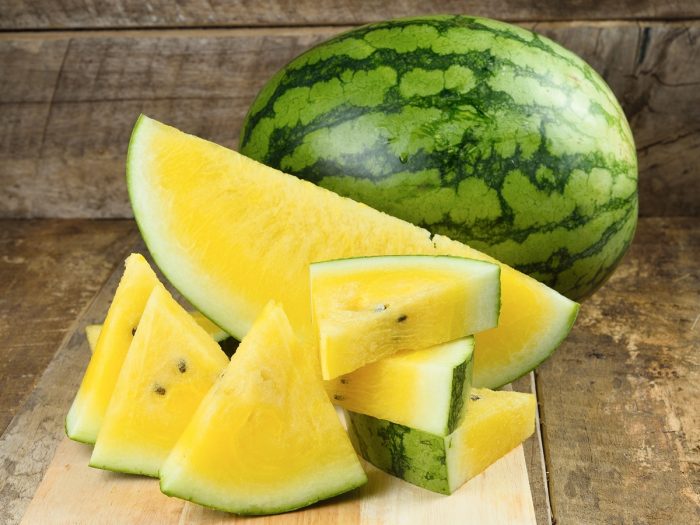For those who have never eaten a yellow watermelon. It may sound like a made-up fruit by the haters of red watermelon! However, this unusually colored melon variety is very real, and packs quite a nutritious punch!
What is Yellow Watermelon?
Yellow watermelon is just the same as any other watermelon, except in color, it is yellow, due to its flesh on the inside instead of the more common pink or red color. People use yellow watermelon the same way they’d use any other type of red flesh watermelon.
It is a natural variety of watermelon that has experienced a genetic mutation in which it does not produce any (or very low levels of) lycopene. [1]
Color
These yellow varieties of watermelon are actually the original form of watermelon and were first cultivated in Africa. According to a study in the Journal of Food Composition and Analysis, lycopene is the compound that gives color to many popular fruits and vegetables such as tomatoes and red watermelon. It wasn’t until these fruits were made into more popular commercial fruits that they were bred for higher lycopene content. [2]
Taste
The taste of a yellow watermelon is slightly sweeter than its red cousin, and almost has tastes of honey or apricot in the delicious flesh of the fruit. The rind of these watermelon goes deeper into the fruit, but the uniquely colored and flavorful flesh makes it worthwhile.
Nutritional Value of Yellow Watermelon
Yellow watermelons contain many of the same nutritional properties as normal red watermelon, with some notable differences. Recent research suggests that these watermelons contain high levels of vitamin A and vitamin C – 18 percent and 21 percent of your daily requirements, respectively, in each cup of this fruit. There are less than 50 calories in a one-cup serving, as well as moderate amounts of potassium and sodium. While red watermelon is high in lycopene, yellow-colored watermelons are high in beta-carotene, another very powerful antioxidant often found in sweet potatoes and carrots. [3] [4]

Add cubed yellow watermelon to your salads to make them colorful. Photo Credit: Shutterstock
Using Yellow Watermelon
There are many uses for yellow watermelon, largely the same as red watermelon. [5]
- The consistency is the same, as is the summary nature of this fruit, making it a popular addition to fruit salads and fruit smoothies.
- You can also juice yellow watermelon for a nutrient-dense and powerfully sweet beverage.
- They are good to eat raw, or as a base for a light, refreshing salad.
- You can also cut these watermelons up and serve slices at your next summer party!
Storage of Yellow Watermelon
If you plan to keep yellow watermelon for a longer period of time, it is important to know the proper way to store them.
- If you are storing an uncut yellow watermelon, they can be stored on the counter for 2 weeks before they begin to spoil.
- Regularly turning the watermelon will prolong the shelf life.
- You can store the watermelon in the refrigerator for 2-3 weeks before cutting it.
- After cutting a part of the watermelon off, however, be sure to cover the exposed side with a plastic of some kind (a hairnet or plastic wrap works very well for this purpose).
Before cutting this type of watermelon, be sure to wash the rind thoroughly, as they are prone to retain some residues of plant chemicals and pesticides. Sliced yellow watermelon can also be stored in the refrigerator for 3-5 days, but will begin to lose some sweetness and juiciness after that point.
Difference Between Red & Yellow Watermelon
The primary difference between red and yellow watermelon, as mentioned above, is the difference in chemical compounds. The pigment compounds found in red watermelons are lycopene, whereas yellow watermelons contain beta-carotene, the same chemical that gives color to carrots. [6]
Red Watermelon
Outer Color: Striped Green
Flesh Color: Bright Red
Taste: Sweet and juicy
Seed Color: Black – Also available in seedless varieties
Nutritional Information: Antioxidant Lycopene present
Yellow Watermelon
Outer Color: Striped Green
Flesh Color: Bright Yellow
Taste: Similar to that of a red watermelon – a subtle tinge of honey
Seed color: Black – Also available in seedless varieties
Nutritional Information: Antioxidant beta carotene present
If you are at the local grocery store searching for a wholesome, ripe yellow watermelon, check for melons that are creamy and have a yellowish spot on the rind. A ripe watermelon, yellow or red, should feel slightly heavy also making a hollow sound if you lightly thump it.
Watermelons are usually the yummiest during summers, but that should not deter you from picking a yellow watermelon at any time.
